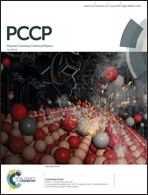Interactions between H-bonded [Cu II3(μ3-OH)] triangles; a combined magnetic susceptibility and EPR study†
Abstract
The X-ray crystal structure of the CuII complex [Cu3(μ3-OH)(μ-pz)3(PhCOO)3]− (pz− = pyrazolato anion) shows an isosceles triangular core, further forming a hexanuclear H-bonded aggregate. Cleavage of the H-bonds in solution results in isolated trinuclear species. Analysis of variable temperature magnetic susceptibility data of a powder sample shows an antiferromagnetically-coupled Cu3-core with a doublet ground state and isotropic exchange parameters (Jave = −355 cm−1, Hiso = −JijSiSj). The fitting of magnetic data requires the inclusion of antisymmetric exchange, AE (HAE = Gij·Si × Sj) with Gz = 31.2 cm−1 and no detectable inter-Cu3 isotropic exchange. X-band EPR spectroscopy in a frozen tetrahydrofuran solution of the compound indicates isolated Cu3-species with g‖,eff = 2.25, g⊥,eff = 1.67. The small value of g⊥,eff (≪2.0) is consistent with the presence of AE in agreement with the analysis of the magnetic measurements. The parallel component exhibits a hyperfine pattern corresponding to one I = 3/2 nucleus with A‖ = 425 MHz. This implies a specific exchange coupling scheme obeying the order |J12| = |J13| < |J23| consistent with the crystallographically determined two long and one short Cu⋯Cu distances. The role of AE in modulating the hyperfine parameters in antiferromagnetic Cu3 clusters is studied. EPR spectra at X- and Q-band were performed with powder samples of the cluster at liquid helium temperatures. The spectra in both bands are consistent with two interacting Sa,b = 1/2 species in the point dipolar approximation. Fitting of the spectra reveals that each spin is characterized by g‖ = 2.24, g⊥ = 1.65 which is in agreement with an isolated Cu3 cluster in the ground state. The determined inter-spin distance of 4.4–4.5 Å is very close to the distance between the Cu(1) and Cu(1)′ sites of the two trimeric units as imposed crystallographically (4.3 Å). This constitutes further verification of the specific exchange coupling scheme within each trimer. Magnetostructural correlations previously adopted for antiferromagnetically coupled Cu3 clusters are discussed in the light of the combined magnetic measurements and EPR spectroscopy.
![Graphical abstract: Interactions between H-bonded [CuII3(μ3-OH)] triangles; a combined magnetic susceptibility and EPR study](/en/Image/Get?imageInfo.ImageType=GA&imageInfo.ImageIdentifier.ManuscriptID=C8CP02643B&imageInfo.ImageIdentifier.Year=2018)


 Please wait while we load your content...
Please wait while we load your content...
